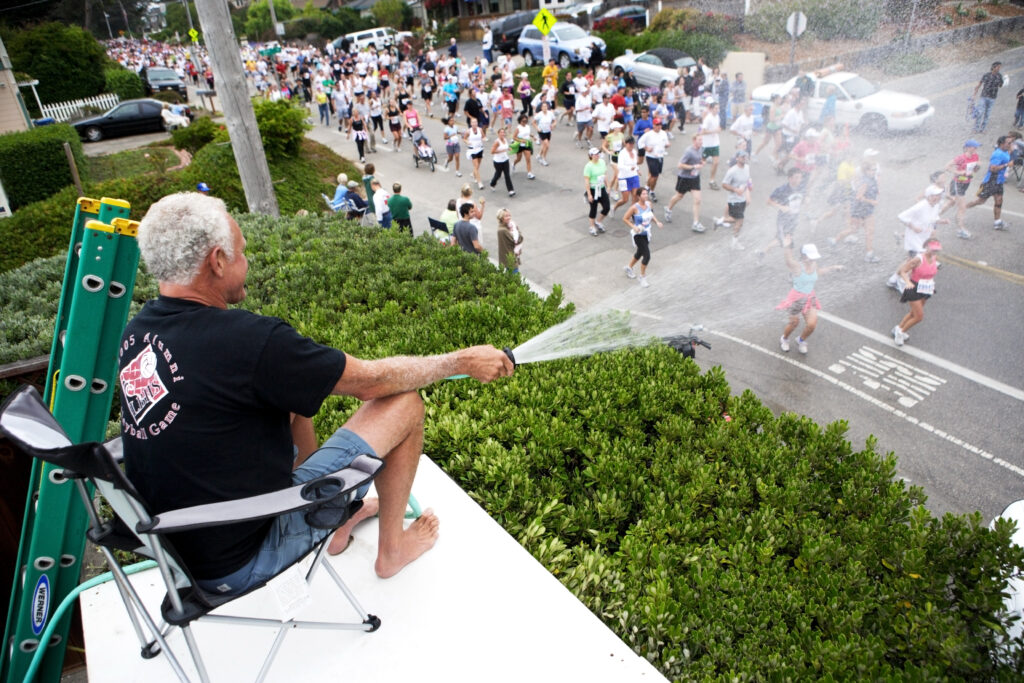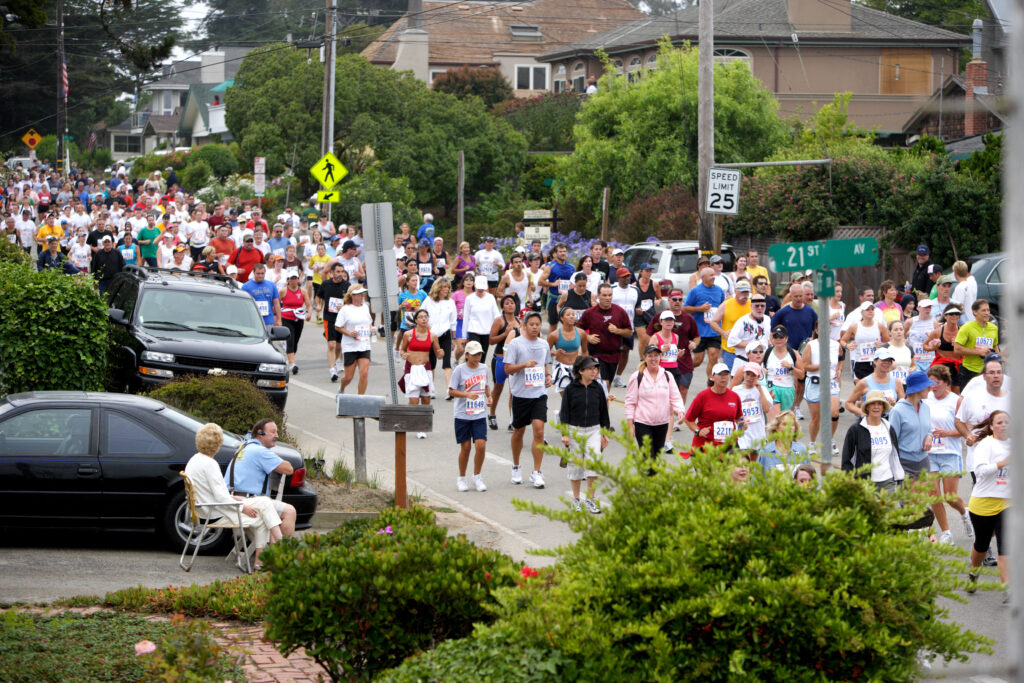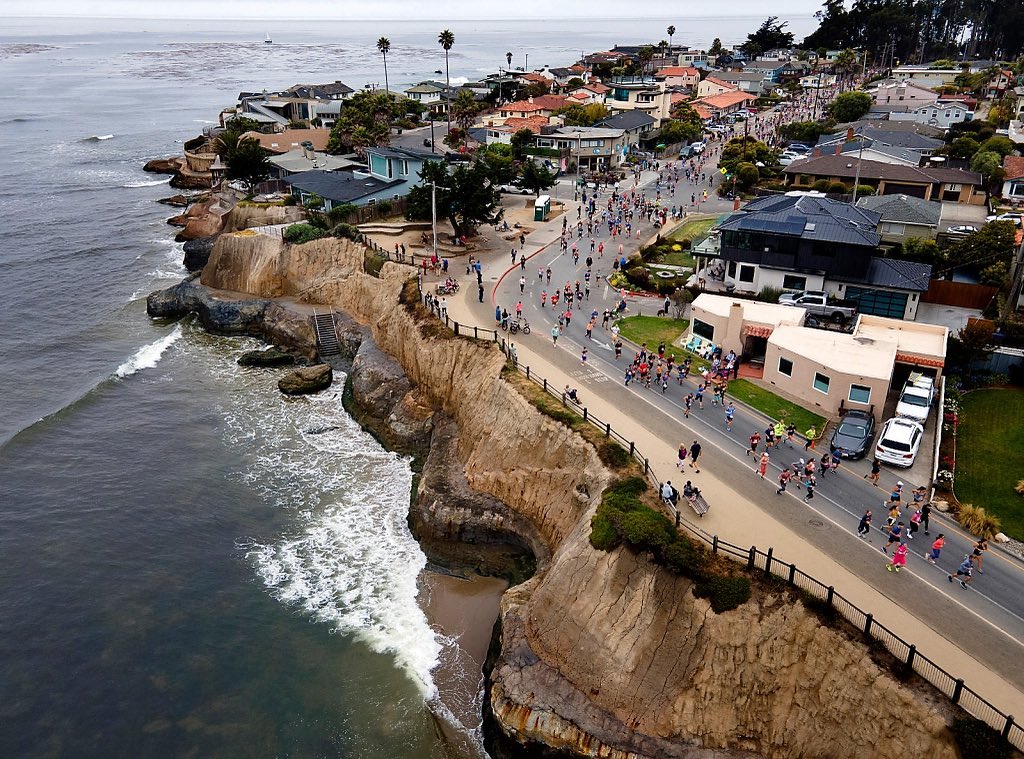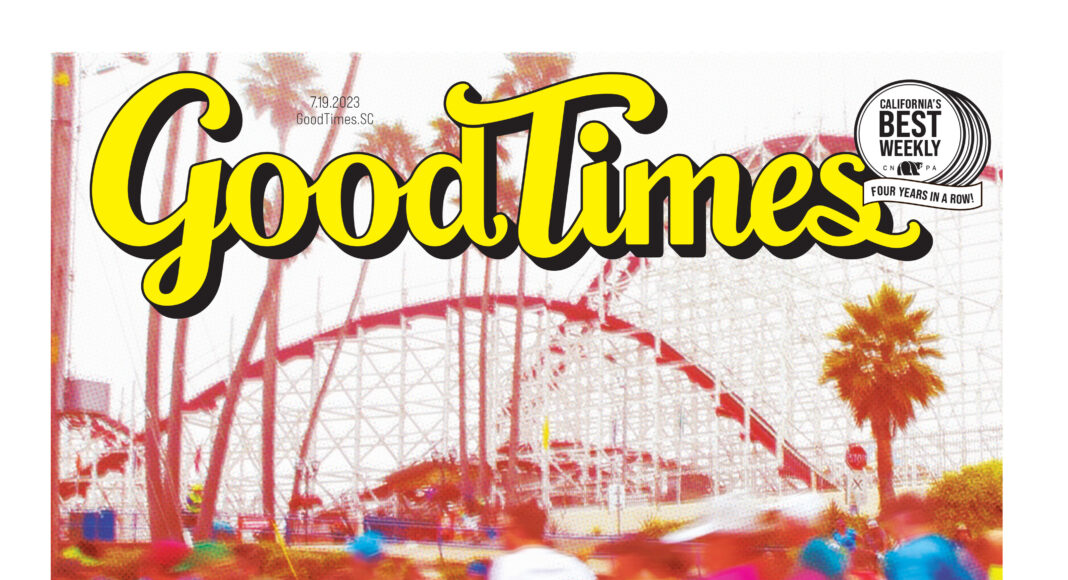With its rich history Wharf to Wharf is back for year 50
For runners, our right to take in our city by foot for miles at a time feels sacred. When the statewide “stay at home” mandate came on March 19, 2020, early in the pandemic, I did the natural thing: I laced up my shoes and ran four miles from where we live in Soquel down to the Capitola Wharf, and along the way encountered people united in being alienated from each other by the challenge of adapting to the new reality. Already that day the thought hit me: They can’t take “Wharf to Wharf” from us.
Actually, they could—in April 2020 came the announcement that because of the pandemic, the 2020 Wharf to Wharf race was being canceled. Ditto, eventually, for the 2021 race. Last year, Wharf to Wharf was back—but I think for many, like me, who missed it for one reason or another, it didn’t feel back. This year, with plenty of time to prepare, when Wharf to Wharf gets underway this Sunday, it will feel like Santa Cruz spirit and Santa Cruz vitality are alive in a way they haven’t been in years.
“One of the things that makes Wharf to Wharf so special, from that original group of 270-something who ran the race, a lot of that humility is still displayed, kind of your backyard BBQ, family fun run where people come far and wide to meet up and run this race,” longtime race director Scott McConville told Good Times.
“You have all walks of life. A lot of races around the country that grew to this size, they turned it into an enterprise and business, and inevitably things just change. Who you are changes. For us, we continue to do the good work in the community, and this is our single North Star that we continue to move towards. I think it’s important to keep the fun and the humility. Despite the size of the event, we want to make sure we don’t lose that.”
For those of us who have run the race often over the years, it feels like a lifeline to the spirit of our community. Let’s face it, day to day life too often funnels down to a few regular stops: Trader Joe’s, Discretion Brewing, Abbott Square, Natural Bridges, whatever your own list might include. We lose sight—literally—of all that lies between. We lose sight of the unique charm of our little stretch of the Central Coast, so beguiling to so many visitors over the years.

in the Wharf to Wharf race from the Boardwalk
to Capitola as he does annually. Photo: imging
Running along East Cliff Drive for Wharf to Wharf, surrounded by others but still somehow alone with your thoughts, it’s easy to feel pulled back to the 1840s when visitors like controversial John C. Fremont were first arriving in these parts, which were then Mexico—and in the case of Fremont, recklessly risking war by veering back to Santa Cruz, with his band of armed men, apparently to scout for a good spot of land for Fremont to build a house for his own family. History does not record the details, but I’m pretty confident Fremont would have grabbed a spot along the Wharf to Wharf route if he’d had a little more time before having the good sense to skedaddle.
Wharf to Wharf from the beginning was a kind of love song to our community as a place where natural beauty brings people together.
As the Santa Cruz Sentinel explained the origins in an article in 1973, the first year the six-mile run was held, “Capitola resident Jim Reding along with Ken Napier, one of the better distance runners in the over-40 age class in California, got the ball rolling for such a race because they ‘wanted something that all ages could compete in.’ Why not a road race?”
Reding, a World War II Navy veteran and Campbell high-school teacher, was inspired by the colorful example of Bay to Breakers, the San Francisco running event first organized in the aftermath of the 1906 earthquake, which evolved into a veritable carnival of costumed revelry. Like Bay to Breakers, Wharf to Wharf’s charm arises from the musicians along the route, lifting spirits, and the mix of serious runners and fun-runners just out to shake a leg.
“Pete Sorenson, a captain in the San Francisco Fire Department and long-time vacationer in Capitola over the years, invited us up to the Bay to Breakers several times to watch,” Reding told the Sentinel in July 1973, “and it was at that time we thought it would be nice to have such a race in Santa Cruz County.”
That first Wharf to Wharf, run by “some 276” participants, according to the Sentinel, was a broader celebration of Capitola, which had recently been granted state historical landmark status as California’s first seaside community founded as a resort.
“Among the contestants were a 5-year-old boy and a 74-year-old San Luis Obispo man,” the Sentinel reported. “Guerin Myall, 55, of Santa Cruz, completed the six-mile journey without problem, as did Paul Spangler, Myall’s senior by 69 years.”
Myall, all these years later, remains very much a local fixture, now publisher of a startup “surf, skate and music” magazine, Totally Tubular, featuring top-level photography. https://totallytubularmag.com
Does he remember that first Wharf to Wharf? He does.
“I remember getting interviewed by one of the news stations and them asking what I did to prepare for the race,” Myall says now. “I clearly remember saying, ‘I had my Cheerios.’”

At the first Wharf to Wharf, the race was so new, the culmination had its comical aspects. “The first nineteen runners had a bit of trouble at the finish when they ran onto the wharf instead of finishing on the beach in front of it, so no official times were taken,”the Sentinel reported at the time.
Longtime Soquel High track and cross-country coach Mark McConnell, a top finisher that year and a winner one year later, can confirm that. He still laughs thinking about running close behind Jack Bellah, his running teammate at Stanford.
“I knew where the course was supposed to go, I’d helped drag it with a wheel to measure it,” McConnell recalls. “I was close enough to Jack to see him make a turn onto the wharf and my thought was, ‘What’s going on? Did they decide at the last minute it would be cool to finish on the wharf?’ I followed Jack onto the wharf and so did about 20 people. That was a little embarrassing, but a fun story for the last 50 years.”
Runners this year will not have that problem, especially since the Capitola Wharf remains closed because of storm damage. Wharf to Wharf organizers have united behind the community effort to bring back the wharf—and to do so with style and local flair.
Anyone visiting the Wharf to Wharf homepage (wharftowharf.com) has noticed a bright orange tab reading: BEGIN FUNDRAISING NOW-CLICK HERE. And in orange letters, the admonition: “Help Rebuild the Capitola Wharf” and the explanation, “In partnership with the City of Capitola and the Capitola Wharf Enhancement Project, the Wharf to Wharf Race is fundraising to build back the Capitola Wharf better than ever!”
Scott McConville, taking a break from his hectic pre-race preparations, emphasized in a phone interview how important the cause was to everyone associated with Wharf to Wharf. “We’ve done a good job in the community for the 50 years we’ve existed, and operated under the mission of giving back and pouring money into the community to give youth equipment and facilities and opportunities to enjoy the sport of running,” he said.
“I think sometimes the landscape and the size of our event overshadow the work that we do. As we turn to the page to the next 50 years, we’re trying to focus on keeping up that work and letting the community know what we’re doing. We want to make sure that we keep getting the word out so we can keep those opportunities happening in the future.”
Last January, when epic storms knocked out the wharf, which was suddenly missing a section, and President Joe Biden and Governor Gavin Newsom were visiting, the Wharf to Wharf team felt called upon.
“This year when the storm happened early in the year, and our registration opening was a few months away, we thought right away, ‘How can we get involved in the rebuild of the community where our race finishes?’” McConville said. “At the time it felt so catastrophic and it felt so damaging, it took us a while to realize this isn’t just something we can do for the community, this is actually our name, this is our finish line. This is not just a feel-good thing. This is impactful for who we are.”
The result of that thinking was a close partnership. As an established 501(c)(3) nonprofit organization, Wharf to Wharf could legally serve as a conduit for donations, jumpstarting the fundraising effort, all without taking a cut. As the Biden visit highlighted, FEMA money was on its way, but much more was needed if the opportunity was going to be taken advantage of to create a vibrant new wharf environment.
Come to think of it, listening to McConville talk about his vision, maybe when the work on the wharf is completed, race organizers will have to go back to the original (unintended route) and finish on the wharf.
“Here’s a once-in-a-lifetime opportunity for us to make this actually something that people want to be visiting when they come to town, an extension of the restaurants in the Village,” McConville said, and gushed about possibilities like public viewing of art and sculpture unique to the area, interactive children’s exhibitions, widening of at least some of the wharf and on and on.
It’s an appealing vision, one that amounts to stripping away the ravages of time to make the wharf and the area around it feel as fresh and magical as it did for earlier generations. The wharf was originally constructed in 1857 as “Soquel Landing.”
“Santa Cruz County is still moving; and the propelling forces of the subject may drive us into enthusiasm, not only on the many resources which surround us, but also the varied beauties connected with them,” the Santa Cruz Weekly Sentinel wrote in 1867, and added this detail: “Soquel Landing is about one mile below the town and has a wharf, where the freight is shipped and the steamer Salinas formerly received a supply of fresh water. The town and vicinity has two stores, three sawmills, two grist mills, two tanneries, three blacksmith and wagon maker’s shops, saddler shop, etc.”
The first published reference to “Capitola wharf” comes in an odd anecdote in the Sentinel in September 1885, when a boat was chartered for a wedding, “the party made its appearance on Camp Capitola wharf,” and the “blushing bride was assisted into the boat by the trembling hand of the bashful groom.”
In October 1887, Santa Cruz Surf reported, “James Buero, a Soquel fisherman, while out fishing with his nets near Capitola … discovered that he had caught a sea monster of some kind. … The monster was, after much laborious work, towed to the beach near Capitola wharf, and proved to be an immense sea turtle, the largest of its species that has ever been caught on the coast. On being measured, it was found to be eight feet in length from its nose to the tip of his tail.”
And in August 1890, commenting on the fishing industry, Santa Cruz Surf reported, “Capitola wharf is a great seat for this industry, and seats are taken by both old and young all round it. ‘Keep in the middle of the wharf,’ is good advice, or your dress or coat may get hooked, and someone will say, ‘I really beg your pardon.’”
Wharf to Wharf somehow taps into all of that history, stretching from near the Santa Cruz Wharf to the Capitola Wharf. Any real local feels or senses the deeper truth of the history of the Capitola Wharf, a sign of the energy that brought new arrivals to these shores, a physical manifestation of the profound connection between our settlements and the thriving life of the ocean that nourishes us—and that, as any of us who have run Wharf to Wharf knows for ourselves, gives this race a special power to inspire.

PHOTO: wharf to wharf
Given all that has hit us in recent years, two years without Wharf to Wharf, the epic storms that caused so much damage in Capitola Village and through the region, this year’s running of Wharf to Wharf feels more than ever like a celebration of life itself—and that’s how Mark McConnell feels about it. He hasn’t run the race in decades, but he’ll be out there this Sunday.
“I’m actually going to run it this year, largely because I turned 70,” he said. “One of the things that helped Wharf to Wharf grow was simply the beauty of the course. People like to come to Santa Cruz and the race is a good excuse. Not too many races can compete with Santa Cruz.”
Another participant in the first Wharf to Wharf will also be out there on Sunday: Guerin Myall, 5 years old for the first one. He’s run it close to 30 times, he reckons, but this year he’ll be walking the course—“my ankles, my knee, I’m just kind of broken down right now”—along with his dad, Jed, 84, and mom, Helen, 83.
“I can’t get out of it,” he jokes. “I have to do it—then I take off to Hawaii a couple days later. Wharf to Wharf is a celebration of everything in Capitola, all the businesses. It is very special. You get Santa Cruz, it’s a total little utopia, we don’t have trends like Southern California. We’re this little bubble, and to have this race grow from a few hundred, it’s been awesome to watch it grow throughout the decades.”













